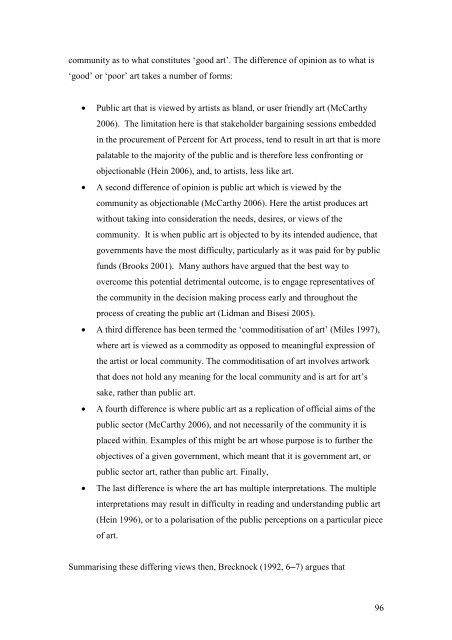Multi Outcome Construction Policy (final report)
Multi Outcome Construction Policy (final report)
Multi Outcome Construction Policy (final report)
You also want an ePaper? Increase the reach of your titles
YUMPU automatically turns print PDFs into web optimized ePapers that Google loves.
community as to what constitutes ‘good art’. The difference of opinion as to what is‘good’ or ‘poor’ art takes a number of forms:• Public art that is viewed by artists as bland, or user friendly art (McCarthy2006). The limitation here is that stakeholder bargaining sessions embeddedin the procurement of Percent for Art process, tend to result in art that is morepalatable to the majority of the public and is therefore less confronting orobjectionable (Hein 2006), and, to artists, less like art.• A second difference of opinion is public art which is viewed by thecommunity as objectionable (McCarthy 2006). Here the artist produces artwithout taking into consideration the needs, desires, or views of thecommunity. It is when public art is objected to by its intended audience, thatgovernments have the most difficulty, particularly as it was paid for by publicfunds (Brooks 2001). Many authors have argued that the best way toovercome this potential detrimental outcome, is to engage representatives ofthe community in the decision making process early and throughout theprocess of creating the public art (Lidman and Bisesi 2005).• A third difference has been termed the ‘commoditisation of art’ (Miles 1997),where art is viewed as a commodity as opposed to meaningful expression ofthe artist or local community. The commoditisation of art involves artworkthat does not hold any meaning for the local community and is art for art’ssake, rather than public art.• A fourth difference is where public art as a replication of official aims of thepublic sector (McCarthy 2006), and not necessarily of the community it isplaced within. Examples of this might be art whose purpose is to further theobjectives of a given government, which meant that it is government art, orpublic sector art, rather than public art. Finally,• The last difference is where the art has multiple interpretations. The multipleinterpretations may result in difficulty in reading and understanding public art(Hein 1996), or to a polarisation of the public perceptions on a particular pieceof art.Summarising these differing views then, Brecknock (1992, 6–7) argues that96
















